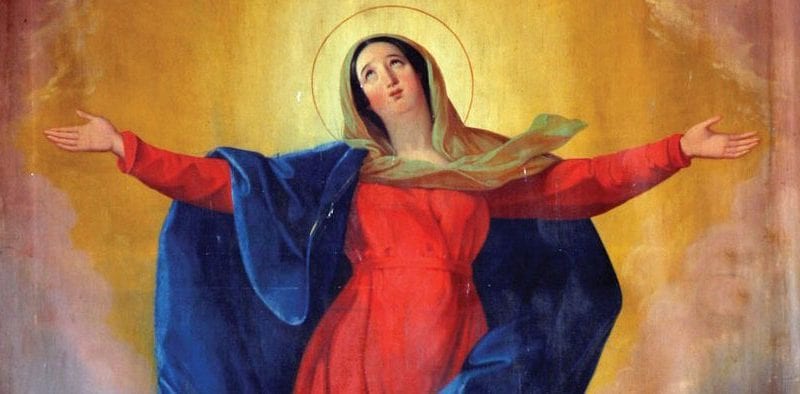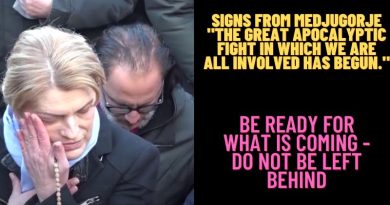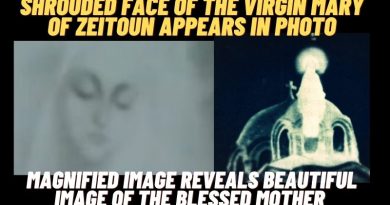7 Reasons to Declare A New Marian Dogma Now
Source Mother of All People


Six cardinals and bishops from the five continents have authored a respectful open letter to Pope Francis (see www.openletterformary.com) which requests the Holy Father to consider solemnly defining the unique human role of Mary in the Redemption accomplished by Jesus Christ.
The cardinals and bishops state that they are making this public appeal to Peter’s Successor in light of “so much suffering” in the world, coupled with their grave concern that there is “more to come.” The prelates maintain that the papal proclamation of a “dogma” regarding Mary’s Spiritual Motherhood will lead her to “fully exercise her maternal mediation on our behalf.” The episcopal signatories believe a new Marian dogma will bring forth a new historical outpouring of grace: “We are convinced that the Father awaits his church to specifically and dogmatically honor [Mary’s] co-redemptive role with Jesus, for which he will respond with a historic new outpouring of his Holy Spirit.”
The cardinals and bishops conclude: “Our Lord gave Peter the keys of the kingdom. We ask you, dear Holy Father, to use them now, in these dramatic times, and with your powerful word, in the fullness of your office as Successor of Peter, to proclaim the great role that the Virgin Mary played in God’s plan of Redemption. Surely, it will release great graces for today!”
The unparalleled role of the Mother of Jesus in the saving work of Jesus Christ already constitutes the authoritative doctrinal teaching of the Church’s Magisterium. The Second Vatican Council repeatedly teaches this unique coredemptive role of Mary with and under Jesus, and her consequent intercessory roles as Mediatrix and Advocate for humanity:
…the Blessed Virgin advanced in her pilgrimage of faith, and faithfully persevered in her union with her Son unto the cross, where she stood, in keeping with the divine plan, enduring with her only begotten Son the intensity of his suffering, associated herself with his sacrifice in her mother’s heart, and lovingly consenting to the immolation of this Victim which she herself had brought forth (Lumen Gentium 58).
And again:
She conceived, brought forth and nourished Christ. She presented Him to the Father in the temple, and was united with Him by compassion as He died on the Cross. In this singular way she cooperated by her obedience, faith, hope and burning charity in the work of the Savior in giving back supernatural life to souls. Therefore, she is a mother to us in the order of grace (Lumen Gentium, 61).
St. John Paul II referred to Mary as the human “Co-redemptrix” with Jesus, the only divine Redeemer, on at least seven occasions. The great John Paul would further teach and preach the greatest quality and quantity of the theology regarding Marian coredemption in the history of the Church.
If Mary’s unique role in the Redemption is already an official doctrine of the Church, what then would be the benefit of the Holy Father declaring it as a new dogma?
Here are 7 foundational reasons why the contemporary Church and world would profoundly benefit from a solemn definition of Mary as the Spiritual Mother of all peoples (inclusive of her three maternal roles as Co-redemptrix, Mediatrix, and Advocate).
1. Releasing historic graces for the Church and the world: Fully Activating Mary’s Motherly Intercession


During the horrors of World War I, the renowned Belgian Cardinal Desìre Mercier initiated a petition drive to Pope Benedict XV for the dogmatic definition of Mary’s universal mediation. What was Mercier’s rationale for a new Marian dogma? He argued that a solemn declaration of Mary’s roles of intercession would lead to “great graces for the world,” especially the grace of world peace. By 1918, hundreds of cardinals and bishops and hundreds of thousands of clergy and faithful sent petitions to the Holy Father in support of the Marian proclamation.
By the early 1920’s, St. Maximilian Kolbe joined his strong support to his international Army of the Immaculate. Theological support for the Marian doctrines of Co-redemptrix and Mediatrix of all graces the dominated the Mariology of the 1940’s and 1950’s. Although Pope St. John XXIII made it clear from the offset of the Second Vatican Council that it would not be a council defining new dogmas but rather a pastoral council, the doctrines of Marian coredemption, mediation, and advocacy are, once again, explicitly and repeatedly taught (Lumen Gentium, 56, 57, 58, 61, 62).
Since 1993, over 8 million petitions from the People of God spanning some 180 countries have been sent to the Holy See in support of a fifth Marian dogma. Over 600 bishops and 70 cardinals have joined the People of God in their petition to the Holy See. These millions of faithful and hundreds of prelates generally share the same belief as the movement’s founder over a century ago: this papal proclamation of Mary’s universal spiritual motherhood will lead to a historic release of grace for the Church and for the world. The recent cardinal and bishop signatories in their open letter to Pope Francis voice precisely the same conviction.
The theological justification behind the expectation of historic graces though this new Marian dogma would be as follows: God the Father so respects human freedom that grace cannot be forced upon humanity. The free consent of humanity is required for Our Lady to most fully intercede on our behalf. The Holy Father, therefore, as Vicar of Christ on earth and supreme authority of the Church, must freely and solemnly acknowledge Mary’s unique human role in the Redemption and her consequent role as the world’s spiritual Mother in order for Our Lady to fully and most powerfully exercise her motherly roles of intercession for the world.
We see the same theological principle revealed in the biblical institution of the papacy. In Mt. 16:15-20, Jesus asks the apostles the question, “Who do they say that I am?” Jesus, of course, knew who He was, yet Jesus wanted to hear the truth freely proclaimed by Peter. Then and only then, upon the condition of free human consent, does Jesus institute the papacy, which as a result leads to all the historic graces that will flow to the Church and world through the papacy.
The millions of faithful presently petitioning Pope Francis believe that a similar phenomenon of a historic grace will flow upon the world once the Holy Father freely and solemnly proclaims Our Lady as the Spiritual Mother of all peoples: an act of free human consent by the Vicar of Christ which will lead to a new and monumental release of grace through Our Lady’s newly proclaimed roles of intercession.
2. The Completion of Marian Dogma: Declaring Mary’s Relationship with Humanity


Up to this point in history, the Catholic Church has proclaimed 4 “dogmas” or solemnly pronounced doctrines about the Mother of Jesus: the Motherhood of God, that is, that Mary is mother of God the Son made man in Jesus Christ (Council of Ephesus, 431); her Perpetual Virginity, which proclaims that Mary was virginal before, during, and after the birth of Jesus Christ (Lateran Council, 649); her Immaculate Conception, that Mary was conceived without original sin, (solemnly defined by Blessed Pope Pius IX in 1854); and her Assumption, which proclaims that Mary was assumed body and soul into heaven at the end of her earthly life (solemnly defined by Pope Pius XII in 1950).
These four dogmas, sublime in their articulation of Our Lady’s unique prerogatives, nonetheless say nothing explicitly about her relation to humanity. The solemn definition of this, Our Lady’s role as the Spiritual Mother of all Peoples, would solemnly proclaim her role as Spiritual Mother of the human family, and thereby effectively bring to dogmatic completion the “whole truth about Mary” (St. John Paul II).
How appropriate that during what many contemporaries believe to be the “climax” of the Age of Mary—an age which boasts of more Marian dogmas declared, more Marian apparitions approved, and more Marian popes than in any other single period of the Church’s history—that her role as our Spiritual Mother would likewise, be solemnly defined.
Authentic love of Mary must be based on authentic truth about Mary. The Rosary, Marian consecration, and the Scapular devotion are all theologically grounded upon the doctrine of Our Lady’s Spiritual Maternity. It is, therefore, appropriate to have a solemn definition of the Marian doctrine upon which the greatest contemporary manifestations of Marian devotion depend.
3. Declaring the Redemptive Value of Human Suffering: Mary Co-redemptrix and our Roles as “Co-redeemers”


A papal definition of Mary Co-redemptrix would manifest to the world the fundamental Christian truth that “suffering is redemptive.” This dogma would inherently highlight the redemptive value of human suffering, which, in an age faced with ubiquitous suffering both spiritual and physical in nature, could provide a quintessential pastoral message to the contemporary Church and world.
While Our Lady’s suffering with her Crucified Son was unparalleled in its depth and in its merit, all Christians are called by St. Paul to “make up what is lacking in the sufferings of Christ for the sake of his body, which is the Church (Col.1:24). Each of us within the Body of Christ has the privilege and responsibility to join the redemptive mission of Jesus and Mary, and by the patient enduring of our sufferings and spiritually uniting them to the sufferings of our Redeemer, can contribute to the mysterious release of graces for human salvation.
St. John Paul repeatedly called all Christians to become “co-redeemers in Christ,” and Pope Benedict XVI called the sick at Fatima to become “redeemers in the Redeemer.” A solemn proclamation of Mary as the human Co-redemptrix with Jesus offers the People of God a perfect human example to imitate in their Christian call to offer our daily sufferings for the redemption of others.
In an age where the evils of euthanasia and suicide are massively on the rise, the world needs a powerful reminder that human suffering is not useless and hopeless, but rather can be both supernaturally redemptive and eternally meritorious.
4. Highlighting the Dignity of the Human Person and Human Freedom: The Human Imperative to Cooperate with Grace


Proclaiming Mary’s free and personal role in the Redemption would also inherently proclaim the dignity of the human person as well as the dignity of God’s most precious gift to man: human freedom. This dogma would recognize in a solemn expression that a free decision of a human being was a necessary element within God’s providential plan for human Redemption.
Numerous contemporary ideologies deny both the dignity of human freedom and the dignity of the human person—from totalitarian regimes like Communist China, to western syndicates of human trafficking (where its principal market is found the United States). A dogma founded on God’s respect for human freedom joined with Our Lady’s perfect exercise of it would innately pronounce the transcendent dignity of the human person and the imperative to respect human freedom in all circumstances—as does the Creator himself.
This Marian declaration would moreover underscore the perennial Catholic teaching on the human necessity to cooperate with grace for our salvation. As St. Augustine conveys in his famous maxim: “God created us without us: but he did not will to save us without us.”
In fact, the Co-redemptrix title may well be the single greatest term that most completely embodies the full Catholic doctrinal teaching on personal salvation, as it necessarily includes authentically Catholic justification principles such as the proper relationships between human freedom and divine providence, grace and free will, faith and works.
Human freedom exercised with human dignity in perfect cooperation with God’s plan of salvation—therein lies the supreme witness of Mary Co-redemptrix.
5. Proclaiming the True Dignity of Woman: Authentic Christian Feminism as Embodied in Mary


This proposed dogma would sublimely underline that the greatest act of human history—the redemption of the human family— is the result of a woman’s active and feminine “yes.”
It was the will of God that the human person to partake most intimately in the greatest divine act for humanity would not be a pope, nor a bishop, nor a priest, nor a man—but rather a woman and a mother. This speaks volumes regarding both the dignity of woman and the true theological, anthropological, and social nature and dignity of authentic Christian feminism.
The providential necessity of a woman’s contribution to the Redemption has been acknowledged throughout Christian history. In 180 A.D., St. Irenaeus refers to Mary’s feminine contribution as “the cause of salvation for herself and the whole human race.” In 1918, Pope Benedict XV authoritatively teaches: “We may rightly say that she redeemed the human race together with Christ.” In 1993, Mother Teresa succinctly conveys the same truth: “No Mary, no Jesus.”
Particularly in a time of the Church when questions and confusions regarding the nature and role of women in the Church are reaching their crescendos, the answer and remedy is Mary. Proclaiming the greatness of Mary and her roles of maternal intercession for humanity will clarify the proper role of women in the Church, leading to their powerful, yet humble service to the Body of Christ.
6. Applying Authentic Catholic Ecumenism to Mary: A Mother Unites her Children


A new dogma on Mary’s role in the Redemption would actually serve authentic ecumenism as delineated by the Church’s Magisterium. What constitutes authentic Catholic ecumenical activity and how does it relate to a potentially new Marian dogma?
The Second Vatican Council instructs:
It is, of course, essential that doctrine be clearly presented in its entirety. Nothing is so foreign to the spirit of ecumenism as a false conciliatory approach which harms the purity of Catholic doctrine and obscures its assured genuine meaning (Unitatis Redintegratio, 11).
In his papal document on ecumenism, Ut Unum Sint, Pope St. John Paul II describes authentic Catholic ecumenical activity in terms of prayer “as the soul” and dialogue “as the body” in pursuit of true and lasting Christian unity within the one, holy, catholic, and apostolic Church of Christ (cf Ut Unum Sint, 21, 28). In regards to areas of doctrinal disagreement such as Marian dogma or doctrine, John Paul strongly condemns any form of doctrinal “reductionism”:
With regard to the study of areas of disagreement, the Council requires that the whole body of doctrine be clearly presented …Full communion, of course, will have to come about through the acceptance of the whole truth into which the Holy Spirit guides Christ’s disciples. Hence all forms of reductionism or facile “agreement” must be absolutely avoided (UUS, n. 36).
And again:
The unity willed by God can be attained only by the adherence of all to the content of revealed faith in its entirety. In matters of faith, compromise is in contradiction with God who is Truth. In the Body of Christ, ‘the way, the truth, and the life’ (Jn.14:6), who could consider legitimate a reconciliation brought about at the expense of the truth? (USS, 36).
Fullness of doctrinal truth and greatest possible clarity of doctrine thereby constitute two essential pillars of legitimate Catholic ecumenical activity.
If then, the expressed purpose of a dogmatic proclamation of Mary’s role in the Redemption is precisely to articulate the fullness of doctrinal truth and the greatest possible clarity of doctrine regarding Our Lady’s Spiritual Motherhood, it cannot, by definition, constitute a violation of authentic Catholic Ecumenism. To hold as such would be to categorically rule out the legitimacy of the last four Marian dogmas, as well the charism of papal infallibility itself regarding Mary itself.
The late John Cardinal O’Connor of New York, in his letter to Pope John Paul II for the fifth Marian dogma, well expresses the dogma’s potential service to true Ecumenism:
Clearly, a formal papal definition would be articulated in such precise terminology that other Christians would lose their anxiety that we do not distinguish adequately between Mary’s unique association with Christ and the redemptive power exercised by Christ alone (Letter to Pope John Paul II, Feb. 14, 1994).
7. Confirmation from Church Approved Private Revelation: Our Lady Wants This Dogma “Now”


Marian Private revelation, even when approved by the Church, can never constitute the theological foundation for a Marian dogma, but can serve as a supernatural confirmation for its appropriateness, importance, and even necessity.
The ecclesiastically approved apparitions of the Lady of All Nations in Amsterdam, Holland (1945-1959), which were declared as “consisting of a supernatural origin” by Bishop Punt of Haarlem-Amsterdam (May 31, 2002) provide precisely such a heavenly confirmation. Not only do the Amsterdam apparitions ratify the appropriateness of a fifth Marian dogma for our time, they further specify this Marian dogma as a heavenly condition for world peace.
On April 29, 1951, the Lady of All Nations articulates heaven’s desire for a new dogma of Mary as Co-redemptrix, as well of as the providential assurance of its certain outcome:
I stand here as the Co-redemptrix and Advocate. Repeat this after me: the new dogma will be the “dogma of the Co-redemptrix.” Notice I lay special emphasis on the word, “co.” I have said that it will arouse much controversy. Once again I tell you that the Church, “Rome” will carry it through and silence all objections. The Church, “Rome,” will incur opposition and overcome it. The Church, “Rome” will become stronger and mightier in proportion to the resistance she puts up in the struggle. My purpose and my commission is none other than to urge the Church, the theologians, to wage this battle….I know well the struggle will be hard and bitter (and then the Lady smiles to herself and seems to gaze into the far distance), but the outcome is already assured.
On May 31,1954, the Lady of All Nations further instructs:
Work and ask for this dogma. You must petition the Holy Father for this dogma…The world is dominated by the spirit of Satan. When the dogma, the last dogma in Marian history has been proclaimed, then the ‘Lady of All Nations’ will give peace, true peace, to the world.
And again in this Amsterdam message of May 31, 1955:
The world has lost its bearings? Well then, nations, put your trust in your Mother. She is allowed to come to you under this new title: Co-redemptrix, Mediatrix, and Advocate. Why do you not ask your Holy Father to pronounce the Dogma the Lady demands?… Once the dogma has been pronounced, the Lady of all Nations will give her blessing…Then, the ‘Lady of All Nations’ will bestow peace. She will help you when this dogma has been proclaimed.
Our Lady’s approved apparitions in Amsterdam are later confirmed by a second Church-approved apparition involving the Lady of All Nations in Akita, Japan. From 1973 to 1981, Our Lady began a series of mystical phenomena in Akita where a wooden statue of the Lady of All Nations wept tears on 101 different occasions (several times in the presence of the local bishop, Bishop John Ito). The visionary at Akita, Sr. Agnes Sasagawa, was taught the Prayer of the Lady of All Nations by her guardian angel in preparation for the mystical visitations of Our Lady. Bishop Ito approved the supernatural authenticity of the Akita events in 1984, and confirmed that these two Church-approved apparitions possess an essential unity when he stated: “Akita is the continuation of Amsterdam.”
Both the Marian messages Amsterdam, and Akita likewise speak of a conditional global catastrophe and other upcoming trials, for which the graces received through the proclamation of the fifth Marian dogma can serve as remedy or mitigation.
From Cardinal Mercier’s initial inspiration of “great graces for the Church and world” to Our Lady’s supernatural confirmation that only with the dogma of Mary Co-redemptrix can she then “bring peace, true peace to the world,” we see truly historic benefits for the Church and the world through a papal proclamation of the fifth Marian dogma.
Those who wish to join in the respectful petitioning of Pope Francis for this dogma may do so by writing a brief letter to the Holy Father (Pope Francis, Vatican City State 00120) or by adding their own personal “fiat” to the open letter of the cardinals and bishops online (www.openletterformary.com).
Most contemporary commentators agree that we will need “help from above” in order to remedy the ubiquitous crises threatening the world and the Church today.
Let us follow the wisdom of the early Church. Let us “fly to the protection” of the “Holy Mother of God” during the present crisis in the Church and in the world.
Let us also follow Our Lady’s urgent plea to “work and ask for this dogma. You must petition the Holy Father for this dogma,” so that she may be “freed” by our human consent to do for the world that which we simply cannot do for ourselves: bring “peace, true peace, for the world.”
Dr. Mark Miravalle
St. John Paul II Chair of Mariology
Franciscan University of Steubenville
Professor of Mariology
Ave Maria University
President, International Marian Association





